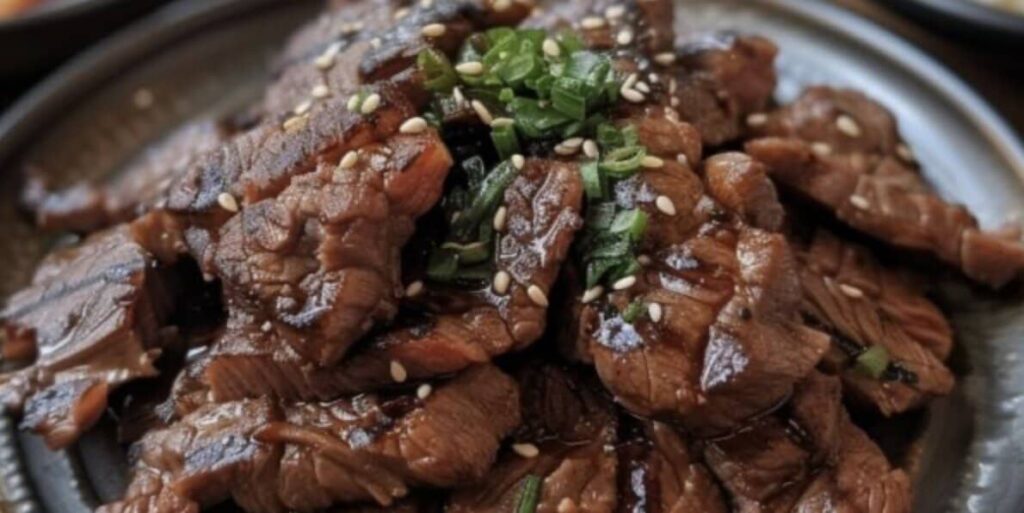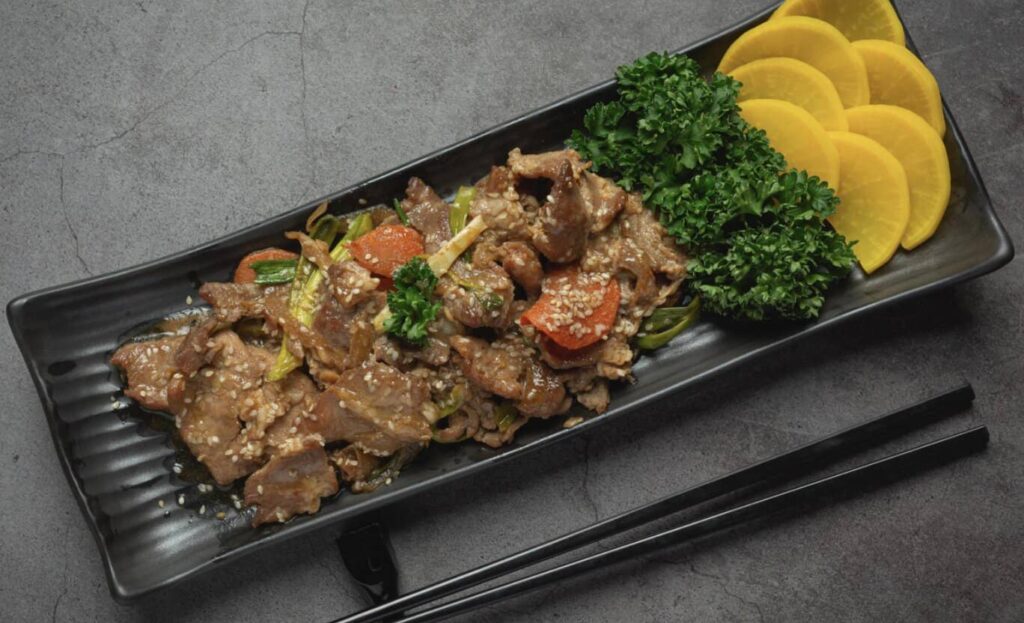Bulgogi is a traditional Korean dish that has been around for centuries. Its name literally means “fire meat,” a nod to the way it was originally cooked over an open flame. The dish is made with thinly sliced beef (or sometimes pork), marinated in a flavorful blend of soy sauce, sugar, sesame oil, garlic, and other spices. It’s not just food—it’s a celebration of Korean culture, enjoyed at family gatherings, barbecues, and even fancy restaurants.
You might think of bulgogi as Korea’s version of a backyard barbecue. But it’s much more than that. Its marinade creates a perfect balance of sweet, salty, and savory flavors, which makes it irresistible.
Table of Contents
The Essence of Bulgogi: Key Ingredients and Preparation Techniques
So, what makes bulgogi so special? It’s all about the marinade and the cut of meat. The marinade usually includes:
- Soy sauce for saltiness.
- Sugar or honey for sweetness.
- Sesame oil for that nutty aroma.
- Garlic and ginger for a punch of flavor.
- Green onions for a fresh, zesty kick.
Pro tip: Use ribeye or sirloin for the best results. These cuts are tender and absorb the marinade beautifully. The meat is usually sliced super thin to ensure it cooks quickly and evenly.
Did you know? Koreans often serve bulgogi with rice, lettuce wraps, and a variety of side dishes like kimchi. The combination of flavors is out of this world!
Why Cooking Technique Matters for Bulgogi
Flavor Development Through Cooking Methods
The way you cook bulgogi can completely change how it tastes. If you cook it over high heat, you get a smoky, caramelized flavor. But if you cook it slowly, it stays juicy and tender. That’s why choosing the right method is so important!
Balancing Tradition and Modern Cooking Trends
Traditionally, bulgogi was cooked over an open flame, which gave it a slightly smoky flavor. These days, people use skillets, grills, or even ovens to cook it. Modern methods are quicker and easier but still aim to preserve the dish’s authenticity.
Understanding the Role of Searing in Bulgogi Recipes
Now, let’s talk about searing. Searing is when you cook the meat quickly over high heat to create a browned, crispy outer layer. It’s like giving the meat a golden crust. But does it really belong in bulgogi?
Searing can enhance bulgogi by:
- Locking in the juices.
- Adding a caramelized texture.
- Intensifying the flavor of the marinade.
On the flip side, it can sometimes dry out the meat or burn the marinade if not done properly.
Should Bulgogi Be Seared? Pros and Cons
The Science of Searing: How It Impacts Texture and Taste

When you sear bulgogi, something magical happens: the Maillard reaction. This is a fancy term for the chemical process that creates those tasty brown bits on the meat. The result? A richer, more complex flavor that’s downright addictive.
Benefits of Searing Bulgogi: Enhanced Flavor Profiles
Here’s why searing works:
- It gives the meat a smoky, slightly charred taste.
- It helps the sugars in the marinade caramelize, creating a mouthwatering glaze.
- It makes the dish visually appealing, with golden-brown edges that scream, “Eat me!”
Potential Drawbacks of Searing: Overcooking Risks and Marinade Loss
But searing isn’t always perfect. If you’re not careful, you might:
- Overcook the thin slices of meat, making them chewy instead of tender.
- Lose some of the marinade in the pan, which can reduce the overall flavor.
- Burn the sugars in the marinade, leaving a bitter aftertaste.
Here’s the key: searing can be amazing, but only if done right.
Traditional vs. Modern Cooking Approaches to Bulgogi
Traditional Grilling Techniques: Open Flame Cooking
In traditional Korean barbecues, bulgogi is cooked on a wire mesh over an open flame. This method gives it a smoky flavor that’s hard to replicate. It’s perfect for outdoor cooking, but not everyone has access to a grill.
Searing on a Hot Skillet or Griddle: A Modern Alternative
Searing bulgogi on a skillet is the go-to method for most home cooks. It’s quick, easy, and doesn’t require special equipment. Just heat up a cast iron or stainless-steel pan, and you’re good to go.
Other Methods: Broiling and Sous Vide Preparation
If you’re feeling adventurous, you can try:
- Broiling: This mimics the high heat of a grill.
- Sous Vide: This ensures the meat stays juicy, and you can finish it with a quick sear.
Each method has its pros and cons, so pick what works best for you!
Common Mistakes When Searing Bulgogi and How to Avoid Them
Overcrowding the Pan: Why Space Matters
One of the biggest mistakes people make is overcrowding the pan. When the pan is too full, the meat steams instead of searing. Always leave enough space between the slices to let them brown properly.
Incorrect Heat Levels: Achieving the Perfect Sear
Too much heat can burn the marinade, while too little heat won’t give you that beautiful crust. Aim for medium-high heat, and preheat your pan before adding the meat.
Using Non-Stick Pans: Why They Might Not Be Ideal
Non-stick pans might seem convenient, but they don’t get hot enough for a good sear. Instead, use a cast iron or stainless-steel pan. These hold heat better and create a better crust.
Key Tips for Perfectly Searing Bulgogi
Choosing the Right Pan: Cast Iron vs. Stainless Steel
When it comes to searing, your pan matters. Cast iron pans are great because they get super hot and distribute heat evenly. Stainless steel pans are another solid choice if you want a quick cleanup.
Proper Marinade Application: Retaining Flavors During Searing
Don’t drown the meat in marinade right before cooking. Instead, let the meat soak up the flavors beforehand, then pat it dry. This prevents the marinade from burning in the pan.
Ideal Temperature and Cooking Duration for Best Results
The sweet spot for searing bulgogi is medium-high heat. Cook each slice for about 1–2 minutes per side. The meat should be browned on the outside but still juicy inside.
“Searing isn’t just cooking—it’s an art form. Nail it, and you’ve got a masterpiece on your plate.”
Common Questions About Searing Bulgogi
Can Bulgogi Be Cooked Without Searing? Alternatives Explored

Here’s the million-dollar question: do you really need to sear bulgogi? The short answer is no, but it depends on your priorities. If you’re aiming for the smoky flavor that searing provides, it’s hard to skip this step. However, there are alternatives.
For example:
- Grilling: Using a tabletop Korean BBQ grill or an outdoor grill can replicate the traditional smoky flavor.
- Slow Cooking: If tenderness is your goal, slow cooking bulgogi in its marinade can yield a softer, juicier texture.
- Stir-Frying: This is a great option if you’re short on time. Stir-frying keeps the meat tender but skips the crispy edges of searing.
Each method has its perks, but searing remains the go-to choice if you want that caramelized, rich flavor.
Does Searing Add Calories to Bulgogi? Nutritional Insights
One common concern is whether searing adds extra calories. The good news? Searing itself doesn’t significantly impact the calorie count. However, the oils or fats you use during the process might.
Here’s a quick tip: Use minimal oil—just enough to coat the pan—and opt for healthy choices like sesame oil or avocado oil. These not only enhance the flavor but also keep the dish light and nutritious.
How to Maintain the Authenticity of Bulgogi While Searing
Some people worry that searing might take away from the authenticity of bulgogi, especially if it’s not grilled traditionally. But remember, the heart of bulgogi lies in its marinade and tender texture.
If you’re searing, focus on:
- Preserving the marinade’s flavors: Avoid burning the sugars by keeping an eye on the heat.
- Using the right cut of meat: Thin slices of ribeye or sirloin are best for staying tender during quick, high-heat cooking.
- Pairing with classic sides: Serve with rice, lettuce wraps, and banchan (side dishes) to maintain the Korean BBQ experience.
As long as these elements are intact, your bulgogi is as authentic as it gets.
Solutions to Searing Challenges in Bulgogi Preparation
Addressing Marinade Loss: Pre-Searing and Post-Searing Techniques
One challenge with searing bulgogi is losing some of the marinade in the pan. But don’t worry—there’s an easy fix!
- Pre-Searing Tip: Pat the meat dry before placing it in the pan. This helps the meat caramelize without the marinade burning.
- Post-Searing Tip: Save some marinade on the side and drizzle it over the cooked bulgogi for an extra punch of flavor.
Pro tip: Deglaze the pan with a splash of water or broth after cooking to create a flavorful sauce from the browned bits.
Adjusting Heat Levels for Even Cooking
Have you ever ended up with meat that’s burned on the outside but raw inside? That’s a classic sign of cooking at the wrong temperature.
Here’s the fix:
- Start with medium-high heat for the initial sear.
- Once the meat is browned, lower the heat slightly to cook through without overcooking.
This method gives you the best of both worlds: a crispy exterior and a tender, juicy interior.
H3: Enhancing Sear Marks for Aesthetic Appeal
Let’s be honest—food that looks good tastes even better. If you want those Instagram-worthy sear marks on your bulgogi, here’s how to achieve them:
- Use a grill pan: The ridges on a grill pan mimic the effect of cooking over an open flame.
- Avoid moving the meat too much: Let it sit undisturbed for at least 1 minute before flipping to create those perfect sear marks.
“Good food is like a painting. The better it looks, the more people want to dig in!”
Final Thoughts: Should You Sear Bulgogi?
Combining Tradition with Personal Preferences
When it comes to cooking bulgogi, there’s no one-size-fits-all answer. Searing adds a smoky, caramelized flavor that many people love, but it’s not a must for everyone. If you want to stick to traditional methods, grilling over an open flame offers an authentic experience. On the other hand, searing can bring a modern twist to this classic dish.
Think about your preferences. Do you love crispy edges with a slightly charred taste? Then searing is for you. Do you prefer soft, melt-in-your-mouth beef? Try a low-and-slow cooking method instead. The beauty of bulgogi lies in its adaptability.
Customizing Techniques to Fit Your Kitchen and Taste
Your kitchen setup also plays a big role. Don’t have a grill? No problem! A cast iron skillet or grill pan works just as well for achieving that beautiful browning. If you’re short on time, stir-frying bulgogi is quick and keeps the meat tender.
The trick is to experiment. Start by searing a small batch and grilling another. Compare the flavors and textures. Cooking isn’t just about following rules—it’s about creating something you love.
“Cooking bulgogi is like painting a masterpiece. You’re the artist, and the kitchen is your canvas.”
Mastering the Art of Bulgogi: Experiment and Enjoy
Perfecting bulgogi is a fun journey. Whether you choose to sear it, grill it, or try a completely new method, the most important thing is to enjoy the process. Cook with love, taste as you go, and don’t be afraid to make mistakes—they’re just steps toward your perfect bulgogi.
Why not host a mini-Korean BBQ night and let everyone try their hand at cooking bulgogi? Add some lettuce wraps, kimchi, and rice to complete the experience. Trust me, the joy of sharing this dish with family and friends makes it even more special.
😊 With these tips, you’re ready to dive into the world of bulgogi cooking. Remember: the best bulgogi is the one that makes you happy! Let me know if you need help exploring any other dishes or techniques. 🍽️

